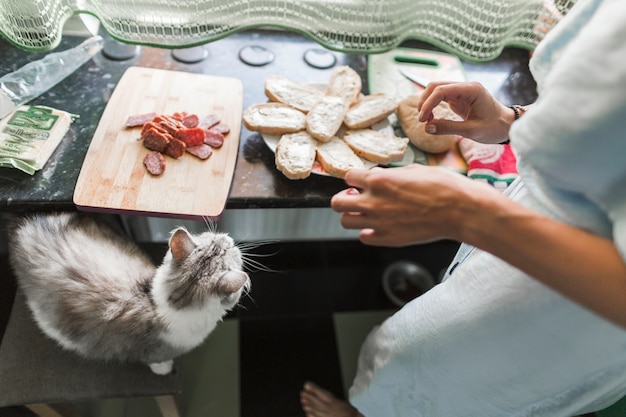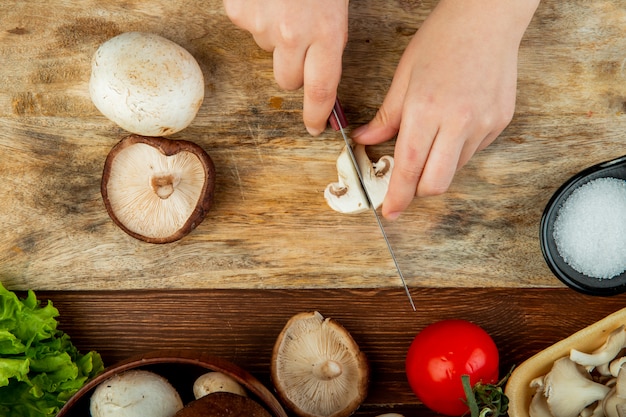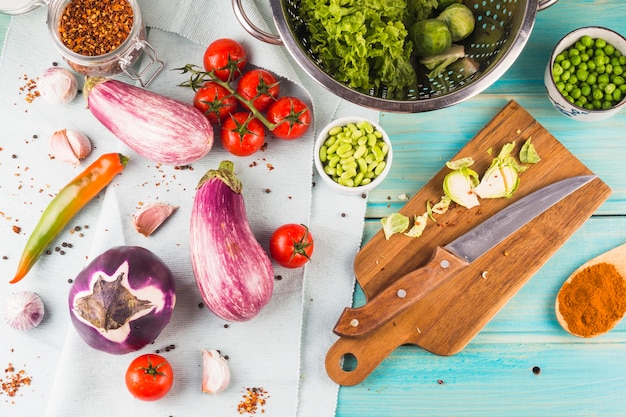Let's face it, rabbit has been unfairly relegated to the back of the culinary stage for far too long. It's time to give this delightful and versatile meat the attention it deserves! As a seasoned food enthusiast, I've been championing rabbit for years, and I'm thrilled to share my passion with you.
This guide is your comprehensive roadmap to all things rabbit, from understanding its unique qualities to mastering the art of preparing and cooking delicious dishes. We'll dive deep into the world of rabbit, exploring its history, its nutritional benefits, and the myriad ways you can showcase its flavour. We'll learn how to break down a rabbit, explore the different cuts, and master various cooking techniques like roasting, braising, and stewing. By the end of this journey, you'll be a confident rabbit chef, ready to impress your family and friends with mouthwatering meals.
So, grab your apron, sharpen your knives, and let's embark on this delicious adventure!
(Part 1) The Rabbit's Tale: A culinary journey

A Taste of History
Rabbit has a rich culinary history, dating back centuries. In medieval Europe, it was a staple food, particularly for those who couldn't afford the luxury of larger game. It was readily available, affordable, and a source of much-needed protein. Fast forward to the 20th century, and rabbit experienced a resurgence of popularity as a healthy and lean alternative to red meat. However, its popularity waned again in many Western countries, leaving it as a somewhat forgotten culinary gem.
Rabbit: A Versatile Ingredient
Don't let rabbit's relative obscurity fool you; this is a truly versatile ingredient! It's a blank canvas for culinary creativity, lending itself to a wide range of flavours and cooking styles. Imagine succulent roasts with crispy skin, aromatic stews simmered to perfection, fragrant curries bursting with flavour, and even delicate pasta sauces with a hint of game. Whether you prefer rustic farmhouse fare or sophisticated restaurant-style dishes, rabbit is more than up to the task.
The nutritional powerhouse
Beyond its culinary versatility, rabbit is a nutritional champion. It's a lean protein source, low in fat and calories, making it a healthy choice for those seeking a balanced diet. It's also packed with essential vitamins and minerals, including B vitamins, iron, and zinc.
(Part 2) Sourcing and Selecting the Perfect Rabbit

From Farm to Table
The quality of your rabbit starts with its origin. Ideally, you'll find a local farm or butcher who specializes in rabbit. This ensures you're getting fresh, ethically raised rabbits. Ask about the breed and their feeding practices to gain an understanding of how the rabbits are raised.
Choosing the Right Rabbit
When selecting a rabbit, look for one that's firm to the touch, with a healthy, slightly pink hue. Avoid rabbits that have a strong odour or a discolored appearance. A whole rabbit is often a great option, giving you more control over the preparation process.
Ready to Cook
If you're buying a whole rabbit, you'll need to butcher it before cooking. Don't be intimidated! There are plenty of tutorials online to guide you through the process. Alternatively, you can ask your butcher to do the butchering for you, or buy pre-cut pieces like legs, saddles, or loin, which are perfect for grilling, roasting, or pan-frying.
(Part 3) Preparing for Rabbit Perfection

The Art of Buttering
Buttering a rabbit is a simple yet essential step that enhances flavour and keeps the meat moist. This is a classic technique that elevates rabbit dishes to a new level. Simply rub a mixture of softened butter, herbs, and spices all over the rabbit. This creates a flavourful crust while preventing the meat from drying out, resulting in a tender and juicy final product.
The Magic of Marinades
Marinades are another wonderful way to infuse rabbit with flavour and tenderness. You can use simple marinades like lemon juice and herbs, or get creative with more complex combinations like soy sauce, ginger, and garlic. Allow the rabbit to marinate for at least an hour, or up to overnight for maximum flavour development.
Seasoning to Perfection
The right seasoning is crucial for bringing out the best in rabbit. While simple salt and pepper are always a good starting point, don't be afraid to experiment with other flavours. Try rosemary, thyme, garlic, paprika, or even a hint of chilli for a kick. The key is to enhance, not overpower, the natural flavour of the rabbit.
(Part 4) Rabbit Recipes: A Culinary Symphony
Roast Rabbit: A Classic Delight
Roasting is a simple yet elegant way to cook rabbit. The result is a succulent and aromatic dish that showcases the natural flavour of the meat. Simply season the rabbit generously with salt, pepper, and your favourite herbs. Roast in a preheated oven until the meat is golden brown and cooked through. For a complete meal, add vegetables like carrots, onions, and potatoes to the roasting pan.
Braised Rabbit: Slow and Savoury
Braising is a technique that excels at tenderizing rabbit while creating a rich, flavorful sauce. Start by browning the rabbit in a pan, then add a flavorful broth, wine, or even beer. Simmer gently until the meat is incredibly tender and the sauce has thickened. Serve with crusty bread for a hearty and satisfying meal.
Rabbit Stew: A Comforting Classic
Rabbit stew is a classic comfort food that evokes warmth and coziness. Brown the rabbit with onions, carrots, and celery, then add a rich, flavorful broth. Simmer until the rabbit is tender and the vegetables are soft, and serve with a dollop of creamy mashed potatoes or a sprinkle of fresh parsley.
Rabbit Curry: A Spicy Adventure
For a flavour explosion, try a rabbit curry. The leanness of rabbit makes it an excellent choice for a curry, and its mild flavour blends beautifully with aromatic spices. Brown the rabbit with onions and garlic, then add a flavorful curry paste, coconut milk, and your favourite vegetables. Simmer until the sauce thickens and the rabbit is tender, and serve with rice or naan bread.
Rabbit with Pasta: A Light and Delicious Meal
Rabbit is a fantastic ingredient for pasta dishes, adding a touch of elegance and depth of flavour. Sauté the rabbit with garlic, onions, and mushrooms, then add a splash of white wine and a handful of herbs. Toss the cooked rabbit with your favourite pasta, and top with grated parmesan cheese for a light and delicious meal.
(Part 5) Beyond the Basic: Rabbit Delights
Rabbit in a Pie: A Hearty and Delicious Treat
Rabbit in a pie is a traditional British dish that's sure to impress. Braised rabbit with vegetables and herbs is nestled in a pastry crust and baked until golden brown. Serve with a dollop of cream or a side of mashed potatoes for a truly indulgent meal.
Rabbit Paella: A Spanish Fiesta
Rabbit paella is a vibrant and flavorful dish that's perfect for a party. Cook the rabbit with saffron, chorizo, and vegetables, then add to a pan of rice and broth. Cook until the rice is tender and the rabbit is cooked through, and serve with a squeeze of lemon.
Rabbit Stir-Fry: A quick and easy meal
Rabbit stir-fry is a quick and easy meal that's perfect for a busy weeknight. Cut the rabbit into small pieces and stir-fry with your favourite vegetables, spices, and sauce. Serve with rice or noodles for a healthy and satisfying meal.
Rabbit Skewers: A Grilled Delight
Rabbit skewers are a delicious and easy way to grill rabbit. Thread pieces of rabbit onto skewers with your favourite vegetables, like bell peppers, onions, and zucchini. Grill until the rabbit is cooked through and the vegetables are tender.
Rabbit with Fruit: A Sweet and Savoury Combination
This might sound unusual, but trust me, rabbit with fruit is a delicious combination. The sweetness of the fruit cuts through the richness of the rabbit, creating a truly unique flavour. Try pairing rabbit with apples, pears, or even figs. The sweetness complements the gamey notes of the rabbit, creating a symphony of flavours on your palate.
(Part 6) Tips for Cooking Rabbit Perfection
cooking times
The cooking time for rabbit will vary depending on the cut and the method you're using. A whole rabbit will take longer to cook than individual pieces. It's always best to check the meat's internal temperature to ensure it's cooked through. Use a meat thermometer to check for an internal temperature of 165 degrees Fahrenheit (74 degrees Celsius).
Avoiding Dryness
Rabbit can be a little dry if not cooked properly. To prevent this, use a combination of moist cooking methods like braising, stewing, or slow cooking. You can also use butter, marinades, or sauces to keep the meat moist and flavorful.
Bone-in or Boneless
Whether you choose bone-in or boneless rabbit is a matter of personal preference. Bone-in rabbit will have more flavour and a richer texture, but it can be more difficult to prepare. Boneless rabbit is easier to cook and can be cut into smaller pieces for easier handling.
Serving Suggestions
Rabbit pairs well with a variety of sides, from classic mashed potatoes and roasted vegetables to more adventurous dishes like couscous, rice pilaf, or even a simple green salad. Get creative and experiment with different flavour combinations to find your favourites. The possibilities are truly endless!
(Part 7) Rabbit Recipes: A Culinary Journey
A Simple Rabbit Roast
This classic recipe is perfect for a beginner rabbit chef.
Ingredients:
1 whole rabbit
2 tbsp butter, softened
1 tbsp fresh rosemary, chopped
1 tbsp fresh thyme, chopped
1 tsp salt
1/2 tsp black pepper
Instructions:
1. Preheat oven to 350 degrees fahrenheit (175 degrees Celsius).
2. Rub the butter all over the rabbit, ensuring even coverage.
3. Sprinkle the rabbit with rosemary, thyme, salt, and pepper, ensuring a generous coating.
4. Place the rabbit in a roasting pan and roast for 1 1/2 to 2 hours, or until the meat is cooked through and the internal temperature reaches 165 degrees Fahrenheit (74 degrees Celsius).
5. Let the rabbit rest for 10 minutes before carving and serving. This allows the juices to redistribute, resulting in a more tender and flavorful meal.
Rabbit Stew with caramelized onions
This comforting stew is packed with flavour and perfect for a cold winter's day.
Ingredients:
1 tbsp olive oil
1 1/2 lbs rabbit, cut into pieces
1 large onion, sliced
2 carrots, chopped
2 celery stalks, chopped
2 cloves garlic, minced
1 cup dry white wine
2 cups chicken broth
1 bay leaf
1/2 tsp dried thyme
Salt and pepper to taste
Fresh parsley, chopped, for garnish
Instructions:
1. Heat the olive oil in a large dutch oven over medium heat.
2. Add the rabbit pieces and brown on all sides. This creates a beautiful crust and enhances the flavour.
3. Remove the rabbit from the pan and set aside.
4. Add the onions to the pan and cook until caramelized, about 10 minutes. Caramelizing the onions adds depth and sweetness to the stew.
5. Add the carrots, celery, and garlic and cook for 5 minutes more.
6. Stir in the white wine, chicken broth, bay leaf, and thyme. The white wine adds a touch of acidity, while the chicken broth provides a rich base for the stew.
7. Return the rabbit to the pan.
8. Bring the mixture to a boil, then reduce heat to low, cover, and simmer for 1 1/2 to 2 hours, or until the rabbit is tender.
9. Season with salt and pepper to taste. Adjust seasoning to your preference.
10. Garnish with fresh parsley and serve with crusty bread.
(Part 8) FAQs: Your Rabbit Cooking Questions Answered
What is the best way to cook rabbit?
The best way to cook rabbit depends on your personal preference. Roasting, braising, stewing, and stir-frying are all excellent methods for cooking rabbit. Experiment with different techniques to find your favourites.
How long does it take to cook rabbit?
The cooking time for rabbit varies depending on the cut and the method you're using. A whole rabbit will take longer to cook than individual pieces. It's always best to check the meat's internal temperature to ensure it's cooked through. Use a meat thermometer to check for an internal temperature of 165 degrees Fahrenheit (74 degrees Celsius).
What does rabbit taste like?
Rabbit has a mild, delicate flavour that's similar to chicken, but with a slightly gamier note. It's a very versatile meat that can be cooked in a variety of ways and pairs well with different flavours.
Is rabbit healthy?
Rabbit is a healthy and nutritious meat that's low in fat and calories, and a good source of protein, vitamins, and minerals. It's a great alternative to red meat for those who are looking for a healthier option.
Where can I buy rabbit?
Rabbit can be found at some supermarkets, but it's more readily available at specialty butcher shops or from local farms. You can also find rabbit online from a variety of suppliers.
(Part 9) The Rabbit Revolution: Embracing a Delicious Future
It's time to embrace the rabbit revolution and discover a whole new world of flavour! Let's celebrate the versatility and deliciousness of rabbit, bringing it back to the forefront of culinary creativity. Don't be afraid to experiment with different recipes, techniques, and flavours. The culinary possibilities are endless, and I promise you won't regret adding rabbit to your regular menu. Get ready to impress your loved ones with delicious and nutritious meals featuring this often-overlooked culinary treasure!
Everyone is watching

How to Cook Frozen Lobster Tails Perfectly: A Step-by-Step Guide
RecipesLobster. Just the word conjures up images of lavish meals, special occasions, and a taste of luxury. But let's...

Pigs in a Blanket Cooking Time: How Long to Bake for Perfect Results
RecipesAh, pigs in a blanket. Just the name conjures up images of those delightful little parcels of crispy pastry en...

Pork Fillet Cooking Time: How Long to Cook It Perfectly
RecipesPork fillet, or tenderloin as it's sometimes called, is a real favourite in our house. It's so versatile, and...

The Ultimate Guide to Cooking Delicious Frankfurters
RecipesLet's face it, we all love a good frankfurter. It's a classic, simple, and always satisfying. But let's be rea...

Wolf Meat Recipes: A Guide to Cooking Wild Game
RecipesLet's be honest, you don't see wolf meat at your local butcher shop every day. It's a bit of a wild card, but ...
